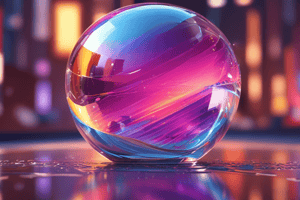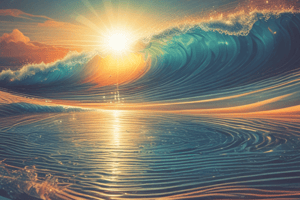Podcast
Questions and Answers
What is the definition of reflection?
What is the definition of reflection?
- Light passing through an object
- Bouncing of light off an object (correct)
- Absorption of light by an object
- Bending of light around objects
What is the difference between regular reflection and diffuse reflection?
What is the difference between regular reflection and diffuse reflection?
- Regular reflection occurs from rough surfaces, while diffuse reflection occurs from smooth surfaces.
- Regular reflection scatters light, while diffuse reflection reflects light smoothly.
- Regular reflection results in scattering of light, while diffuse reflection is when light reflects off a smooth surface.
- Regular reflection happens with mirrors, while diffuse reflection happens with rough surfaces (correct)
What happens if an object is outside the focus in a concave mirror?
What happens if an object is outside the focus in a concave mirror?
- The image is virtual and located behind the mirror
- The image is real and located in front of the mirror (correct)
- The image is virtual and located in front of the mirror
- The image is real and located behind the mirror
What does the refractive index of a medium measure?
What does the refractive index of a medium measure?
What type of images are formed by convex mirrors?
What type of images are formed by convex mirrors?
Which type of mirror produces both real and virtual images?
Which type of mirror produces both real and virtual images?
What is the angle formed between the incident ray and the normal at the point of incidence?
What is the angle formed between the incident ray and the normal at the point of incidence?
What does the Refractive Index of a medium compare?
What does the Refractive Index of a medium compare?
"What type of image is produced when light rays appear to intersect but do not physically intersect?"
"What type of image is produced when light rays appear to intersect but do not physically intersect?"
"What changes when light passes from a vacuum into a medium with a higher refractive index?"
"What changes when light passes from a vacuum into a medium with a higher refractive index?"
Flashcards are hidden until you start studying
Study Notes
Light Basics
- Light is a form of energy that travels away from its source at a speed of approximately 3 x 10^8 ms^-1.
- Light exhibits wave-like nature, undergoing five wave phenomena.
- Light usually travels in straight lines.
Reflection
- Reflection is the bouncing of light off an object.
- The Refractive Index of a Medium is the ratio of the sine of the angle of incidence to the sine of the angle of refraction.
- There are two types of reflection: Diffuse Reflection (off rough surfaces) and Regular Reflection (off smooth surfaces like mirrors).
- A real image is formed by the actual intersection of light rays, while a virtual image is formed by the apparent intersection of light rays.
Laws of Reflection of Light
- Law 1: The incident ray, normal, and reflected ray all lie in the same plane.
- Law 2: The angle of incidence is equal to the angle of reflection (i = r).
Spherical Mirrors
- Concave mirrors produce both real and virtual images.
- Convex mirrors produce only virtual images.
Characteristics of Convex Mirrors
- The image is always virtual and located behind the mirror.
- The image is always diminished.
- The nearer the object is to the mirror, the bigger the image.
Characteristics of Concave Mirrors
- If the object is outside the focus, the image is real and located in front of the mirror.
Studying That Suits You
Use AI to generate personalized quizzes and flashcards to suit your learning preferences.




